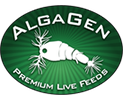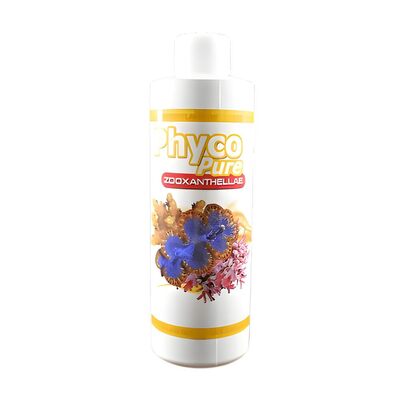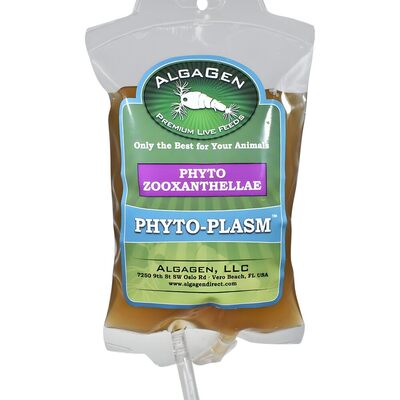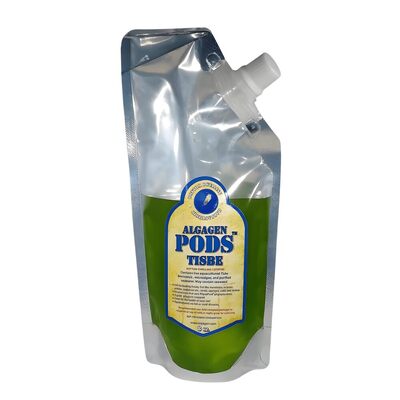AlgaGen as a company is committed to sustainability in all aspects of marine husbandry. We have decided to offer an educational newsletter covering ground breaking advances in the hobby, techniques that will promote sustainability in reef keeping, and conservation news to allow those interested to take on various action-items beneficial to our world’s oceans and reefs.
Interviews with Innovators
Our first interview is with Matthew Wittenrich, Poma Labs
AlgaGen: Tell us about yourself and your current projects. What are you working on?
Matt: “I have been involved with the aquarium industry in one way or another for most of my life. I am a diehard hobbyist and can remember having aquariums just about anywhere they would fit when I was younger. I dabbled in breeding all kinds of freshwater fish. Everything from anabantoids to piranhas. I got the saltwater addiction when I was about 15 when I raised my first clownfish.
I am originally from western New York and began breeding saltwater fish in my parent’s basement, successfully raising 13 species by the time I was 18. During this time, information on breeding marine fishes in captivity was rare, so I began documenting some of this success in TFH magazine. After graduating with a Bachelor’s degree in Marine Biology from Long Island University, Southampton College, I worked in commercial finfish aquaculture and collaborated on various research projects, before pursuing a Masters degree at Florida Institute of Technology. I have been involved in diverse research projects from sex change strategies in pseudochromids, examining if larval clownfish can hear the natal reefs where they hatched, and understanding how larval fishes feed.
I then went on to earn a PhD from Florida Institute of Technology, with research focused on the early life stages of marine fishes, which address both ecological questions about how tiny larvae survive in the wild, as well as developing novel methods suited to rearing them in captivity. This is primarily achieved through understanding the functional design of the feeding apparatus and how it changes through the early life history stages. Through this research he has been successful in identifying stage and species-specific criteria that lead to successful feeding.
One of the things I am most proud of is authoring The Complete Illustrated Breeder’s Guide to Marine Aquarium Fishes. This book along with some of my breeding work with mandarins earned me MASNA’s Aquarist of the Year Award in 2010. A huge honor to me.
Most recently, with the help of my co-founder Nuri Fisher, we have developed a research-based hatchery that focuses on developing methods for rearing difficult marine fish species such as angelfish. We have successfully raised 14 species of marine angelfish and are in the process of expanding our production facility to a new, state of the art campus we have been developing over the last 2 years. We are hopeful this will allow us to expand our production goals and push forward with new research that leads to commercial availability.”
AlgaGen: Do you use live feeds? How important do you think live feeds are to aquaculture and the hobby? What Live feeds organism(s) do you work with primarily?
Matt: “Live feeds are the cornerstone of our operation - and quite possibly the whole of the aquarium industry and the ecology of the oceans. For decades, the bottleneck to producing marine ornamental species was assumed to be a lack of appropriate feed organisms. More recently, we have learned that in fact, the bottleneck is finding appropriate feed organisms in the presence of appropriate environmental conditions. We rely on AlgaGen to obtain clean, pathogen free strains of copepods that we culture as feed organisms.”
AlgaGen: What’s your favorite marine organism and why?
Matt: “I would have to say angelfish, though it’s tough to say which one. I will switch the question a bit and say my favorite fish that I have raised is the longfin conspicillatus x blueline angelfish hybrid. This fish to me, just represents how far the breeding world has come. I think back to raising clownfish in my parent’s basement and the fish we are seeing being raised today by so many talented aquarists and institutions is mind blowing. They were supposed to be impossible to breed, but here we are!”
AlgaGen: What would you like to see for the future of the hobby?
Matt: “Good question. I would say a new generation of open minded, talented aquarists that understands the past and what it took to get here to carry the torch and blaze new, amazing and impossible paths. I would like to see a future of responsibility and sustainability that blends an honest conversation about wild fisheries and aquaculture since we need both!”
AlgaGen Corner
What is microalgae, and why is it valuable to a reef tank?
Microalgae or Phytoplankton are microscopic plants-in general. Some types of microalgae/phyto, are related to bacteria, some are related to higher plants and some behave is ways that resemble animal. We have heard people say that "Phyto is just phyto"-not so at all! Years ago scientists thought there were 10,000's of different types, then 100,000's of different types, now they think millions. Each are different in habitat, nutrition, behavior and appearance. Greenwater or brown water may appear to be just that with the unaided eye but under a powerful microscope the detail is astounding...it becomes art (see photo 3 in slideshow)
Phytoplankton are one of the main contributors to the earth's atmosphere and available oxygen 50-85% (https://earthsky.org/earth/how-much-do-oceans-add-to-worlds-oxygen). As part of photosynthesis they consume nutrients (nitrates, ammonia, phosphate, copper, zinc, cobalt, manganese, etc) and carbon dioxide to grow, produce fatty acids and proteins and produce oxygen.
The addition of LIVE phytoplankton to a reef tank or captive tank is important because it provides critical nutrients such as fatty acids, proteins, anti-oxidants, immune stimulating compounds; it consumes excess nutrient in the systems and utilizes carbon dioxide. In a way it can buffer the system's water and improve water quality.
Next article will discuss the different species that are grown in aquaculture and how to start your own culture.
Did you know?
Predicted species loss due to global warming
Actually, rising temperatures will have a negative impact on phytoplankton and nutrient cycling. With stocks of Phytoplankton dying off there will be no food for the copepods and other zooplankton that eat them which in turn impacts food reserves for fish.
Fifty-five million years ago, ocean acidification led to a mass extinction of ocean creatures. According to fossil records, it took more than 100,000 years for the oceans to recover. Eliminating the use of greenhouse gases and protecting the oceans can prevent this from occurring again. (https://www.thoughtco.com/global-warming-effect-on-marine-populations-143491Check out these links!
https://www.noaa.gov/media-release/noaa-partners-launch-groundbreaking-florida-keys-coral-reef-restoration-effort
NOAA, partners launch groundbreaking Florida Keys coral reef restoration effort
NOAA, partners launch groundbreaking Florida Keys coral reef restoration effortNOAA (National Oceanic and Atmospheric Administration) initiated a ground breaking effort regarding Florida Keys Coral Reef restoration efforts. This effort will preserve and restore 7 selected sites in the Florida Keys. This has been a decades' long effort to revitalize and protect the highly diverse and economically valuable marine ecosystem in the region.
"The project, Mission: Iconic Reefs, calls for restoring nearly three million square feet of the Florida Reef Tract, about the size of 52 football fields, one of the largest strategies ever proposed in the field of coral restoration. Over the next year and beyond, NOAA will support this effort and work with outside partners to secure additional public and private funds." More details can be found at the link above. (see photo 4 in slideshow)
This has been the first edition of the newsletter. please let us know what you think; what we should ad, what we should drop and who to contact for interviews.
Please share this letter if you think it has value!
Interviews with Innovators
Our first interview is with Matthew Wittenrich, Poma Labs
AlgaGen: Tell us about yourself and your current projects. What are you working on?
Matt: “I have been involved with the aquarium industry in one way or another for most of my life. I am a diehard hobbyist and can remember having aquariums just about anywhere they would fit when I was younger. I dabbled in breeding all kinds of freshwater fish. Everything from anabantoids to piranhas. I got the saltwater addiction when I was about 15 when I raised my first clownfish.
I am originally from western New York and began breeding saltwater fish in my parent’s basement, successfully raising 13 species by the time I was 18. During this time, information on breeding marine fishes in captivity was rare, so I began documenting some of this success in TFH magazine. After graduating with a Bachelor’s degree in Marine Biology from Long Island University, Southampton College, I worked in commercial finfish aquaculture and collaborated on various research projects, before pursuing a Masters degree at Florida Institute of Technology. I have been involved in diverse research projects from sex change strategies in pseudochromids, examining if larval clownfish can hear the natal reefs where they hatched, and understanding how larval fishes feed.
I then went on to earn a PhD from Florida Institute of Technology, with research focused on the early life stages of marine fishes, which address both ecological questions about how tiny larvae survive in the wild, as well as developing novel methods suited to rearing them in captivity. This is primarily achieved through understanding the functional design of the feeding apparatus and how it changes through the early life history stages. Through this research he has been successful in identifying stage and species-specific criteria that lead to successful feeding.
One of the things I am most proud of is authoring The Complete Illustrated Breeder’s Guide to Marine Aquarium Fishes. This book along with some of my breeding work with mandarins earned me MASNA’s Aquarist of the Year Award in 2010. A huge honor to me.
Most recently, with the help of my co-founder Nuri Fisher, we have developed a research-based hatchery that focuses on developing methods for rearing difficult marine fish species such as angelfish. We have successfully raised 14 species of marine angelfish and are in the process of expanding our production facility to a new, state of the art campus we have been developing over the last 2 years. We are hopeful this will allow us to expand our production goals and push forward with new research that leads to commercial availability.”
AlgaGen: Do you use live feeds? How important do you think live feeds are to aquaculture and the hobby? What Live feeds organism(s) do you work with primarily?
Matt: “Live feeds are the cornerstone of our operation - and quite possibly the whole of the aquarium industry and the ecology of the oceans. For decades, the bottleneck to producing marine ornamental species was assumed to be a lack of appropriate feed organisms. More recently, we have learned that in fact, the bottleneck is finding appropriate feed organisms in the presence of appropriate environmental conditions. We rely on AlgaGen to obtain clean, pathogen free strains of copepods that we culture as feed organisms.”
AlgaGen: What’s your favorite marine organism and why?
Matt: “I would have to say angelfish, though it’s tough to say which one. I will switch the question a bit and say my favorite fish that I have raised is the longfin conspicillatus x blueline angelfish hybrid. This fish to me, just represents how far the breeding world has come. I think back to raising clownfish in my parent’s basement and the fish we are seeing being raised today by so many talented aquarists and institutions is mind blowing. They were supposed to be impossible to breed, but here we are!”
AlgaGen: What would you like to see for the future of the hobby?
Matt: “Good question. I would say a new generation of open minded, talented aquarists that understands the past and what it took to get here to carry the torch and blaze new, amazing and impossible paths. I would like to see a future of responsibility and sustainability that blends an honest conversation about wild fisheries and aquaculture since we need both!”
AlgaGen Corner
What is microalgae, and why is it valuable to a reef tank?
Microalgae or Phytoplankton are microscopic plants-in general. Some types of microalgae/phyto, are related to bacteria, some are related to higher plants and some behave is ways that resemble animal. We have heard people say that "Phyto is just phyto"-not so at all! Years ago scientists thought there were 10,000's of different types, then 100,000's of different types, now they think millions. Each are different in habitat, nutrition, behavior and appearance. Greenwater or brown water may appear to be just that with the unaided eye but under a powerful microscope the detail is astounding...it becomes art (see photo 3 in slideshow)
Phytoplankton are one of the main contributors to the earth's atmosphere and available oxygen 50-85% (https://earthsky.org/earth/how-much-do-oceans-add-to-worlds-oxygen). As part of photosynthesis they consume nutrients (nitrates, ammonia, phosphate, copper, zinc, cobalt, manganese, etc) and carbon dioxide to grow, produce fatty acids and proteins and produce oxygen.
The addition of LIVE phytoplankton to a reef tank or captive tank is important because it provides critical nutrients such as fatty acids, proteins, anti-oxidants, immune stimulating compounds; it consumes excess nutrient in the systems and utilizes carbon dioxide. In a way it can buffer the system's water and improve water quality.
Next article will discuss the different species that are grown in aquaculture and how to start your own culture.
Did you know?
Predicted species loss due to global warming
Actually, rising temperatures will have a negative impact on phytoplankton and nutrient cycling. With stocks of Phytoplankton dying off there will be no food for the copepods and other zooplankton that eat them which in turn impacts food reserves for fish.
Fifty-five million years ago, ocean acidification led to a mass extinction of ocean creatures. According to fossil records, it took more than 100,000 years for the oceans to recover. Eliminating the use of greenhouse gases and protecting the oceans can prevent this from occurring again. (https://www.thoughtco.com/global-warming-effect-on-marine-populations-143491Check out these links!
https://www.noaa.gov/media-release/noaa-partners-launch-groundbreaking-florida-keys-coral-reef-restoration-effort
NOAA, partners launch groundbreaking Florida Keys coral reef restoration effort
NOAA, partners launch groundbreaking Florida Keys coral reef restoration effortNOAA (National Oceanic and Atmospheric Administration) initiated a ground breaking effort regarding Florida Keys Coral Reef restoration efforts. This effort will preserve and restore 7 selected sites in the Florida Keys. This has been a decades' long effort to revitalize and protect the highly diverse and economically valuable marine ecosystem in the region.
"The project, Mission: Iconic Reefs, calls for restoring nearly three million square feet of the Florida Reef Tract, about the size of 52 football fields, one of the largest strategies ever proposed in the field of coral restoration. Over the next year and beyond, NOAA will support this effort and work with outside partners to secure additional public and private funds." More details can be found at the link above. (see photo 4 in slideshow)
This has been the first edition of the newsletter. please let us know what you think; what we should ad, what we should drop and who to contact for interviews.
Please share this letter if you think it has value!





Recent post